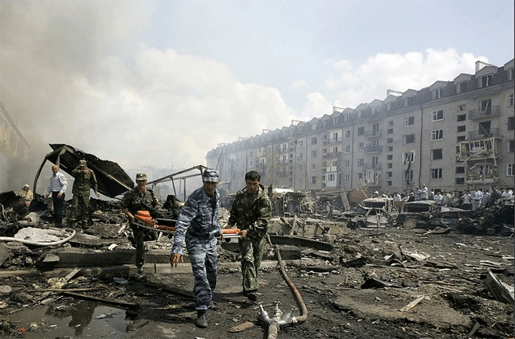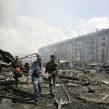
A Review of Martyrdom Operations and the Insurgency in the North Caucasus: 2008 to the Present
Publication: Eurasia Daily Monitor Volume: 8 Issue: 34
By:

In a video address in April 2009 Doku Umarov announced the revival of the Riyadus-Salikhin (Kavkaz Centre, May 17, 2009) – a battalion of martyrs created by the deceased Chechen warlord Shamyl Baev which was responsible for a wave of suicide attacks starting in December 2002, and which culminated in the Beslan School siege of September 2004. The 2009 video address by Doku Umarov –the leader of the Caucasus Emirate– marked a third phase of “martyrdom” operations organized under the aegis of the Riyadus-Salikhin. This cluster of attacks actually began in August 2008 when the Vedeno jamaat launched a suicide operation targeting local federal forces, quickly followed by an assassination attempt directed against the Ingush leader Musa Medov, and a mass casualty attack in Vladikavkaz in November 2008. Less than three years later, Doku Umarov stated that the most recent mass casualty suicide operation –the attack on Domodedovo airport on January 24, 2011, which killed dozens and wounded over 150 bystanders– was once again the work of the martyrdom battalion, the Riyadus-Salikhin (Kavkaz Tsentr, February 4). It was followed by another statement of responsibility, indicating that these operations would “undoubtedly continue in the future” (Kavkaz Tsentr, February 7). But the Domodedovo attack –linked to groups in Ingushetia, according to reports (RIA Novosti, Kavkaz Uzel, February 10) – also illustrates that the insurgency is regional in character; that it often brings together different generations of militants; and that suicide operations are both strategic and tactical.
The Ingush jamaats, and the jamaats in Chechnya, were at the center of “martyrdom” operations in 2009 and through 2010. On June 22, 2009, a female suicide bomber, rammed a car laden with explosives into the convoy of the Ingush President, Yunus Bek-Yevkurov (ITAR-TASS, June 23, 2009). The attack, which occurred on the anniversary of a raid by rebels in 2004, was designed to assassinate Yevkurov. Instead it wounded the Ingush president, and killed and injured a number of his bodyguards. Then, on August 17, another spectacular vehicle borne suicide operation took place, when the police headquarters in Nazran was almost completely destroyed. The attack killed dozens of police officers, and wounded scores more (www.kavkaz-uzel.ru August 20, 2009). These two attacks, and the statements of responsibility that followed, signaled a renewed attempt to kill and assassinate federal representatives and police officials using “martyrdom operations” (Kavkaz Tsentr, August 21, 2009; Interfax, July 8, 2009).
On December 17, 2009, another martyrdom operation in Nazran occurred when a man detonated an explosive-laden car at a road block, apparently in revenge for federal operations (Kavkaz Uzel, December 18, 2009). According to reports, on April 5, 2010 a martyrdom operation took place in the Ingush town of Karabulak, when a man detonated an explosive belt next to a car full of police officials (Kavkaz Tsenter, April 5, 2010). A few days later, allegedly in response both to a federal sweep operation, and a rolling search of the Ingush town of Ekazhevo, a woman opened fire with a pistol at local militiamen, before detonating an explosive belt she was wearing (www.kavkaz-uzel, April 9 ,2010). Another independent or botched operation took place when a man detonated explosives in a car in Prigorodny. The checkpoint attack on August 17 in the disputed Prigorodny region, which was followed by a statement of responsibility, indicated the capacity of the Ingush jamaat to launch suicide attacks inside neighboring North Ossetia (Hunafa.com, August 21, 2010). Even though federal forces targeted and eliminated key members of the Ingush jamaat throughout 2009 and 2010 –killing Said Buryatsky (Kavkaz-uzel.ru, March 4, 2010) and Rustram Dzortov (Kavkaz-uzel.ru, September 5, 2009), and the capture of Emir Magas (RIA Novosti, June 9, 2010) – martyrdom operations continued in Ingushetia.
In August 2010, two months after the capture of Emir Magas –his successor, Isa Khashegulgov (Emir Adam) – made a statement, dated August 2010, which re-affirmed his oath of loyalty to Chechen rebel leader Doku Umarov, on behalf of the Ingush jamaat (Hunafa.com, October 5, 2010). The statement came against the backdrop of infighting between different factions in the North Caucasus insurgency, which led to a split of sorts between the Chechen jamaats led by veteran field commanders, while others in Dagestan, Kabardino-Balkaria and Ingushetia remained loyal to Umarov. Shortly after the pledge of loyalty by Emir Adam, a suicide attacker detonated a car bomb on September 9, 2010, near a market in the North Ossetian capital of Vladikavkaz. The blast, which killed 19 people, was followed by a statement of responsibility by the Ingush jamaat –and by Emir Khamzat of the Riyadus-Salikhin– which indicated that Ossetia was targeted because “Russian infidels”, use it in support of their “expansion in the North Caucasus” (Hunafa.com, September 15, 2010). Statements of support were also issued by the Ingush jamaat, in support of suicide operations by the Dagestani Sharia Jamaat (Hunafa.com, April 1, 2010).
The Chechen jamaats followed the August 2008 attack in Vedeno with a steady escalation in the use of suicide operations throughout 2009 and 2010. This included a series of attacks in the Chechen capital, Grozny and in the surrounding towns. These attacks were often attributed to the jamaats led by veteran field-commanders, notably the groups loyal to the Gakaev brothers (North Caucasus Weekly, September 17, 2009). Since early 2010, however, these attacks increasingly have dwindled, as a more marked series of raids –including attacks on symbols of power– have been used to undermine the iron-grip on the republic by the Chechen President, Ramzan Kadyrov (for example the August 29 attack on Kadyrov’s village stronghold of Tsentoroi; and the October 19 attack on the Chechen Parliament in Grozny).
Meanwhile, in Dagestan martyrdom operations by the jamaats date back to late 2009. On September 1, a bomber detonated explosives in his car at a checkpoint on the Kavkaz federal motorway near the Dagestani capital, Makhachkala (Interfax, September 2, 2010). This was followed on January 6, 2010 by another vehicle borne attack. A bomber, driving a car laden with explosives, attacked the traffic police in the Dagestani capital Makhachkala. The attack killed seven, while scores of others were injured (RIA Novosti and ITAR-TASS, January 6, 2010). This was followed, on March 31, by twin suicide attacks in the Dagestani town of Kizlyar, when, according to reports, two young men detonated person borne explosive devices near to local militiamen (www.kavkaz-uzel.ru, October 20, 2010). Dagestani officials quickly linked the bombings in Kizlyar, to the March 29, suicide attacks on the Moscow metro (RGVT, March 31, 2010). Officials also noted that alleged accomplices from the Dagestani militant underground were eliminated shortly afterwards (Interfax, April 10, 2010; Kavkaz-uzel.ru, May 24, 2010).
However, suicide attacks continued in Dagestan in 2010. On April 29 of that year a car bomb was detonated by a suicide attacker at a federal checkpoint near Khasavyurt. Then a military camp near Buinaksk was attacked at the beginning of September. Three dozen service personnel from the defense ministry were killed or injured in the suicide car bomb attack (RIA Novosti, September 5, 2010). A claim of responsibility was issued by the Sharia Jamaat some weeks later (Sharia Jamaat, October 25, 2010). This was followed on September 24, as a sweeping operation was underway in Makhachkala when a man approached local militiamen before detonating explosives. The attack injured over two dozen bystanders and federal militiamen (Kavkaz Uzel, September 25, 2010). A further suicide attack directed at federal personnel occurred on October 23, when a man triggered a van borne explosive at the entry to a military base in Khasavyurt (Kavkaz Uzel, October 23, 2010).
As if to demonstrate that Dagestan remains the centre of the regional insurgency shootouts continue and a series of major bomb attacks have been averted in recent months. Then, on February 14, a female suicide bomber was reported to have detonated explosives near to the entrance of police station in Makhachkala (RIA Novosti, February 14).
Although the various jamaats in the North Caucasus are, at best, loosely coordinated –each unit has launched a series of “martyrdom operations” in support of the regional insurgency since 2008– as a new wave of local jamaat leaders come to the fore. At present the relentless wave of attacks in Dagestan highlights that this is the current hotspot of the regional insurgency, while the groups in Kabardino-Balkaria have also launched an upsurge in operations in recent months. Since August 2008, some suicide operations can be traced back to Doku Umarov, in his capacity as leader of the regional insurgency. However, other suicide attacks seem to indicate a measure of operational independence from Umarov, as different elements of the regional insurgency (Ingush Jamaat; Vedeno Jamaat; Sharia Jamaat) attack the federal authorities. In contrast to claims by the Russian authorities, the bombing at Domodedovo airport illustrates that continued instability in Chechnya and the North Caucasus may likely result in further martyrdom operations in Moscow.




